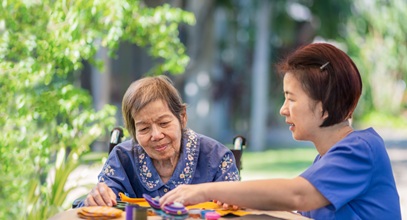If you’ve ever received physical therapy after an illness or injury, there’s a good chance you’ve worked with a physical therapist assistant, or PTA. Under the direction of a physical therapist, PTAs provide direct care to patients, helping them to regain movement and manage pain. PTA duties include assisting the physical therapist in implementing treatment programs according to a plan of care, training patients in specific exercises and daily activities, conducting treatments using special equipment, administering modalities and other treatment procedures, and reporting on the patient's progress and results.
Named among the top 3 Best Healthcare Support Jobs by US News & World Reports, a physical therapist assistant career is an excellent potential choice for people interested in healthcare and anatomy and passionate about helping others. “You have to have a love for the human body,” says Tawny Chamberlain, the Physical Therapist Assistant Program Chair at South University and Program Director at South University, Richmond. “If you don't love anatomy, then it's probably not the right program for you.” The field is also projected to grow by 27% between 2018 and 2028, much higher than the average occupation.
Researching the PTA Field and Programs
Typically, to become a physical therapist assistant, you’ll need to earn an associate’s degree from an accredited program and pass the National Physical Therapy Examination. However, before you commit to becoming a PTA, Chamberlain recommends first talking with a PT or PTA. “The more you talk to clinicians in the field, the better,” she asserts. “Ask them their favorite thing and least favorite thing about the job. There are a lot of healthcare fields and we share many similarities, but we have pretty critical differences too. No one field is better than another. The question is what is the best fit for you, and you only find that out by talking to people in different roles and learning as much as you can about them.”
As you research PTA programs, Chamberlain recommends touring program facilities and meeting with faculty members to learn about their qualifications. “South University’s PTA programs have a lot of faculty members who are very accomplished with different certifications and varied practice experience,” she says. “Many not only have a great education but they're involved in the local community and involved in the field at state and national levels.”
Applying to a PTA Program at South University
At South University, our PTA associate degree programs are CAPTE-accredited (Commission on Accreditation in Physical Therapy Education) and designed to provide students with the skills, knowledge and hands-on clinical experience needed to pursue a PTA career. When you apply to South University, you may be accepted as a PTA program candidate based on your test scores and other academic indicators. From there, you’ll need to complete your general education requirements and prerequisite coursework before applying for admission into the technical phase of the PTA program.
Acceptance into the technical portion is based on criteria like your cumulative GPA, science GPA, ATI TEAS test scores, a background check, drug test, CPR certification and a health screening. South University students are also required to complete 25 hours of observation in a physical therapy setting with a licensed PT or PTA. “Those things are all pretty common requirements for healthcare professions and programs. The observation hours are especially helpful because students get to see professionals in the field and learn more about their work,” Chamberlain explains. “If you don’t know anyone who has had physical therapy before, those observation hours let you see what the experience is all about.”
Succeeding as a PTA Student and Professional
While students can complete our PTA program in as little as two years1, students should know that earning their associate degree will take hard work. Being a PTA student – and later a professional – requires demonstrating strong interpersonal, problem-solving and teamwork skills while communicating and working with faculty, classmates, patients, families and other healthcare workers. “You have to be able to work in a team and you have to be a critical thinker,” Chamberlain states. “You need to be able to ask questions, observe and learn from others, and take the initiative to respond appropriately with informed professional decisions.”
In the classroom, lab facilities and on-site clinical education experiences, students are expected to fully commit to their education and growth. “It's a vigorous curriculum. They hit the ground running and don't slow down,” says Chamberlain. From the start, developing good study habits and earning good grades is important, since being accepted into the technical portion of the program is dependent on academic performance. Of course, the PTA instructors do offer support, and all students should talk with the PTA faculty during their application phase or general education coursework. Chamberlain shares, “For any individual who enters the program, our goal is to do everything we can to see them graduate, pass the licensure exam and get a job in the field. That said, I think the students who are proactive in reaching out to us and getting to know the program are always going to be the most successful.”
To learn more about what it takes to succeed as a PTA and how South University’s PTA programs can prepare you for your career, request more information today.
1Average time to completion is based on successful, continuous, and full-time enrollment.




